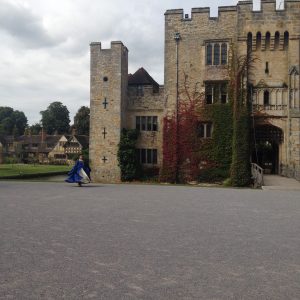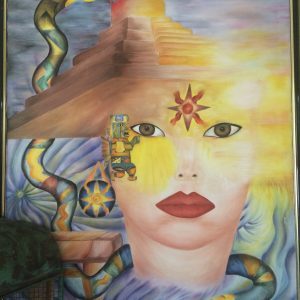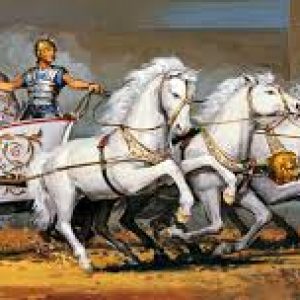Traveller in time?
Relaxing in a blue velour armchair in a dimly lit room in 2002, lawyer Steve* was about to meet his bloody end—as it had taken place almost 1900 years before. In the midst of past life hypnotherapy, the married father-of-two had seemingly uncovered a previous existence as a commanding Roman legionnaire. “We were in a canvas tent discussing the battle-plan. Everything was under control. There was the clinking of swordplay outside as the men sharpened their skills,” he recalls. “I felt upbeat, excited and confident.”
While Steve remains unsure of what to make of his experience, this much is certain: the memory of what happened next has forever changed the course of his present life. At the hypnotherapist’s prompting, he projected forward some days to the battle, but was unprepared for the “incredibly powerful feelings” that consumed him. “I was totally gutted, perhaps in both senses of the word. There were thousands killed—friends, loyal followers, youngsters. It was all my fault. I could barely speak. My eyes were red and wet with tears,” he says. “The feeling of personal responsibility and guilt for leading the men into a massacre was unbearable. The weight of despair is impossible to convey.”
The year, as Steve saw it during the regression, was 111 AD, yet the misery in his words is as palpable as if he were mourning last week’s loss. Whatever forces were at work when Steve took his journey in the Jason recliner, the topic of past lives has enthralled Westerners at least since 1952’s (since debunked) case of a Colorado woman who recalled meticulous details of living as a 19th century Irishwoman named Bridey Murphy. On the net, you’d need a whole separate life just to explore all the websites the subject has spawned. If you’re game, $14.95 is the price to download software that purports to unearth your past lives—one brief credit card transaction, and the rest is history.
Or is it? Whether the memory is true or not is irrelevant, according to Melbourne hypnotherapist Dr. Frank Jockel, PHD. Anxiety, physical pain, fears and phobias, he claims, can melt away with the recollection of a past life. “People look to past life therapy because they feel stuck in a rut, they’ve been to psychiatrists, psychologists, clairvoyants and fortune tellers searching for an answer,” says Jockel. “A client who’s a doctor had a pain in his neck that had been there for a quite a while. During past life therapy, he saw himself being chased by a mob and someone threw a stone and it hit him in the neck. Ask the question ‘Did it actually happen?’ Who knows? But has the pain in the neck gone? Yes.”
Would this work for me? I don’t have a pain in the neck to contend with, but what plagues me—an obsession with King Henry VIII and his six wives—certainly might feel like that to my Tudor-tired family and friends. One glimpse of historian David Starkey on the TV and the blood drains from my husband’s face and he flees, shrieking down the corridor like the ghost of Henry’s fifth wife, Catherine Howard, is said to do. Starkey’s bricklike Six Wives: The Queens of Henry VIII commands my bedside table, and in the kitchen, my trusty Music From the Reign of Henry VIII cassette (yes, cassette) means a volté at breakfast time is never out of the question. Not even a 750-piece puzzle depicting all of Henry’s hounded ladies is beneath me.
Could this fascination endure because I once walked among them? The idea has accompanied me since childhood, and now, with the image of myself in rustling damask reignited, it was time to finally see if I’d lived before.

“Anne Boleyn” dances outside Hever Castle, ancestral home of the doomed queen, in 2014.
First stop was Sydney psychic Kate Barnes. The willowy strawberry-blonde who claims to have channelled Michael Hutchence for Australian Style magazine, describes herself as a medium, healer and clairvoyant—the latter, she explains, means “sight with your eyes” so she’ll view my former selves projected like a film before her open eyes. “I’m looking at a jungle environment,” she declares in her thick-as-the-bush Aussie drawl. “I’ve got a feeling I’m in South America.” It’s an ancient civilisation, probably Incan, and I’m unsettled by her vision that I’ve “had one child torn away” from me for child sacrifice. That heartbreak is likely to make me an over-vigilant mother today, Kate advises, and I’m eager for her to leave that life behind.

My Year 12 major artwork. Why does it feature an Incan pyramid?
“You’ve been a singer!” she suddenly announces, “I can hear this ooaaahh. It’s very operatic: oooahhh.” As she outlines my glamorous life in late 1800s France or England as a “statuesque” chanteuse with a generous cleavage, I’m reminded of my enthusiastic warbling at karaoke—minus the gowns and “many male suitors” that I was formerly accustomed to. As our 90 minute session progresses, I learn that I’ve belly danced in the Middle East, been a courtier at the Palace of Versailles, a jolly 17th century pirate on the Caribbean seas whose ship was swamped by a massive wave (huge waves are my recurring nightmare) and a revolutionary French poet/journalist by the name of Charles Monseurrat. Kate senses that many of the people around me were guillotined in Charles’s lifetime, and I can’t help but remember the red birthmark at the back of the neck that myself, my mother, sister and daughter all share. Chillingly, Kate also met the spirit of my late Godfather. I tensed at her spot-on descriptions of his distinctive gestures, appearance, and her perception of how he died. But where—I had to inquire, when Kate wonders if there’s something she hasn’t “picked up on?”—was my Tudor life?

Is a swashbuckling past behind my passion for the sea?
For as much as I was enjoying her recounting of some of my 600 (!) costume changes—it’s like the MGM wardrobe department has flung open its doors to you for a personal frock-up—when my moment arrived, it was bittersweet. “I can see a removal of collar for a beheading,” says Kate, delicately miming the gesture. If I hadn’t been Anne Boleyn herself—his famous second wife, whom Henry sent to the block on trumped-up adultery charges—I’d been her lady-in-waiting, she states. These words should have made my blood run cold, but coming as a postscript, it was just like chancing upon a beloved, long-dead relative in a well-worn photo album.
Before leaving, I ask if there is any past life explanation for my current fear of driving. In a heartbeat, Kate sees me steering a red-cross ambulance and dodging bombs in some war-ravaged city. This is exhilarating but doesn’t go far towards explaining my terror. When I mention the scene to my mother her dry response is, “I don’t see you driving an ambulance in this life, a past life or a future life.”
Instead, I steered myself towards kinesiology. Energy kinesiology works on the principle that “muscle testing” can identify imbalances in different structures of the body. The practitioner asks a yes/no question and the resistance of your muscle, usually a forearm, provides the answer. This is a novel method of accessing past lives and I can’t imagine what awaits me at the southern Sydney apartment of kinesiologist Sherry Mead. A gargantuan dream catcher dominates most of a wall, and I wonder what lives we’ll net today.
Answering that proved complicated , but warm-natured Sherry showed cool efficiency in keeping track of the interminable folders, information sheets and lists she had to consult in tracking my past lives. “Muscle testing is our tool to follow the path or to find the story,” she explains. Via what is essentially the method of elimination, Sherry established that I’d been a swordsman in the Spanish royal court in 1521 (right year, wrong country) and a 9-year-old Greek girl in 1013. I thanked Sherry, but more than ever; I was drawn to the bright light of hypnosis.
Hypnotherapy is the quintessential past-life experience, as Steve discovered. “I had been pretty risk averse in my life and reluctant to push myself forward and stand-out from the group,” he says. “The Roman legionnaire experience certainly showed why I might have retreated into a shell. Soon after this experience, I felt that perhaps there was a reason for my ‘blockage’ and it was okay to move on and start asserting myself.” He soon grasped a new professional opportunity and moved interstate with his family. “There is a new energy, excitement and happiness. Now I stand up for what I think is right.”
That’s settled then: I will go under. Imagining my ancient self skipping down velvet English hills, I make an appointment with Sydney hypnotherapist Marlaine Nicholson-Smith.
“Hypnosis is like the dream state but awake,” Scottish-born Marlaine informs me during our pre-session chat. “I have to quieten the conscious mind to access the subconscious. The memories are there within you but a lot of us don’t want to remember, or don’t now how to remember.” For the first few moments in the recliner’s plush embrace, as Marlaine’s hushed voice instructs me to feel “heavy as lead”, I’m remembering only that I’ve left my mobile phone switched on in the next room.
The pesky thought eventually recedes during the guided meditation, where I’m to imagine myself walking down a golden path, inhaling a rainbow of multi-hued “mists.” Soon, I’m plunged into a swirling spiral and when I emerge at the other side, I’m supposedly inside a past life. Then—nothing. But pictures do emerge as, ever so slowly, I lose awareness of where I am, and start to completely inhabit the landscape in my mind. Still, when I listen back to a recording of the session, my answers remain mostly monosyllabic and the vivid detail reminiscent of the most intriguing past life recollections I’ve read about is absent.

During hypnosis, I’m advised to “inhale” a rainbow of multicoloured mists.
I “see” a barefoot young woman with long dark hair, and an empty stone cottage, but there’s no one around—it’s like a ghost town. When I’m asked for the date, there is a long pause before my clipped “1500s”—of course I’d say that, in my hope. Yet, propelled to the day I departed this mundane life, a tear stung my eye as I watched this girl whose features were never clear die in her childbed. Marlaine later assured me that memories are often hazy: “Often, you don’t get a proper picture, you just get a feeling that something’s there.”
The second life I recounted—intended to pinpoint the origins of my fear of driving—flowed better. This time I’m a stable boy of 15 in the days of Roman chariots. He’s as happy as Larius until the day his master invites him to take the reins, for a lark, and the horse and chariot veer wildly out of control, throwing the youth and condemning him to be reborn centuries later as a bus-bound writer with a thing for strappy shoes that lace around the ankle. To curtail my fear, Marlaine suggests that I reimagine the event with a happy ending, then “One: feeling your body return to normal. Two: feeling your spine against the chair, and three: wide awake and refreshed.” I snap my eyes open and drag my tingly, leaden limbs from the chair, thinking all the while that it would have been fun to continue for just one more life…

What? More Romans?! A chariot accident may explain my fear of driving…
Barry Williams, the editor of The Skeptic, the journal of the Australian Skeptics association, soon bursts my bubble: “Self delusion is one of the strongest attributes that all human beings have,” he cheerfully tells me. While he immediately poo-poos the psychic reading—“she was never going to tell you that you were a common rag picker who spent most of his time with his finger up his nose”—and my brush with kinesiology–“one of the looniest things people have come to believe”—hypnosis makes him pause for breath. “It is on the fringes of science … the hypnotist is giving you permission to behave how you wouldn’t normally behave, make a fool of yourself if you like.” (Here, I chose to remember the celebrities who cross-dress for TV hypnosis specials, rather than my own purposeful utterings about a crashed chariot.) “You want this to be true,” he sums up. “It’s the same as when people see pictures in clouds.”
But that’s not so bad, is it? Bombarding my vague and pregnant sister with tales of my spiritual quest recently, she surprised me with a decisive: “You know what you were. You don’t need to ask anyone.” Perhaps, I thought, sinking into the couch with my latest guilty pleasure—Robin Maxwell’s The Secret Diary of Anne Boleyn—you could have told me that earlier.
* Not his real name

No answers: the mystery of my fascination with Anne Boleyn remains. (Image Hevercastle.co.uk).
Author’s note: I was commissioned to write this article for a Sunday supplement more than a decade ago, but it was never published. My sister suggested I post it, so here it is, a little dated in parts, but hopefully still of value. Something that’s definitely changed since I wrote this is I now believe more in the idea of “simultaneous” lives, rather than “past” lives … more on that later!





